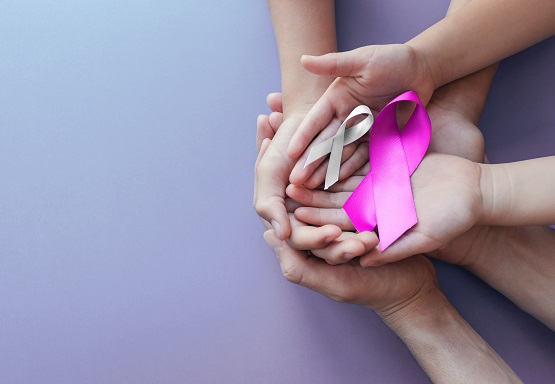Personalised Medicine for Breast Cancer

On 19 September 2020, Mount Alvernia Hospital and Icon Cancer Centre jointly organised a livestreamed event, supported by Mundipharma Singapore. Our on-campus specialist Dr Lee Guek Eng spoke on the use of personalised medicine in the treatment of breast cancer, and the management of their side effects. Here are some of the highlights.
BREAST CANCER, THE MOST COMMON CANCER AMONG FEMALES
Before fielding questions submitted by online attendees, Dr Lee spoke about the rising incidence of breast cancer, which has tripled since the 70s. She also confirmed that an increasing number of cases of early-stage breast cancers are being detected, which may be largely due to increased screening.
Dr Lee is seeing more younger women with breast cancer, which she believes is partly due to a growing awareness of the fact that breast cancer is not solely confined to older women. Hence younger women are now more likely to do self-breast examinations, go for screenings and report changes in their breasts to their doctors.
Changes that warrant further investigation include lumps in the breasts, changes in skin texture, changes in the shape of the nipples and breasts, and nipple discharges. However, Dr Lee stipulated that not all of these signs indicate the presence of breast cancer.
What are the typical treatment options for breast cancer?
Dr Lee:The treatment for each patient is highly individual. Before developing a treatment plan, we look at the stage and profile of the cancer.
Based on the absence or presence of hormone receptors for progesterone and oestrogen, and receptors for HER2, we characterise the cancer as one of three sub-types – hormone receptor-positive, HER2-positive and triple negative. For example, hormone treatment is generally only suitable for patients with hormone receptor-positive sub-types of cancer.
In the case of a diagnosis of Stage IV cancer, the usual process would be a systemic treatment with chemotherapy. Most treatment plans adopt a multi-disciplinary approach.
Hormone receptor-positive breast cancers are generally less aggressive than HER2-positive and triple-negative cancers. However, in recent years, current medicines and therapies have improved success rates across all sub-types. Triple-negative breast cancers are generally the most difficult to treat.
What are the common side-effects of breast cancer treatment and how can they be managed?
Dr Lee:The severity of side-effects varies from patient to patient. I advise my patients not to listen to the horror stories and wait to see how their bodies react to their treatment. Though nausea is a common side effect, its portrayal is exaggerated in movies and dramas. Besides, we always pre-medicate the patient with anti-nausea medicine before chemotherapy, and after. Hair loss is also quite common, but is only temporary. Once the chemotherapy has been completed, the hair will grow back. Wigs and scarves can of course help women boost their confidence during their treatment.
Bone density loss is another side-effect for post-menopausal women undergoing hormone treatment for breast cancer. Injections for preventing bone loss during hormone treatment in post-menopausal women are quite effective, but should always be combined with diet and exercise.
How does cancer treatment affect fertility for younger women?
Dr Lee: This is a very important question for younger patients who have not completed or even begun their family planning. For women who desire childbirth after a breast cancer diagnosis, I strongly encourage them to consult a gynaecologist before commencing their treatment.
Is it possible for benign lumps to become cancerous?
Dr Lee: Benign lumps can be caused by many things and need to be evaluated, as some can be associated with an increased risk of cancer developing later on. To ascertain that a lump is benign, the radiologist will look at the imaging. If the imaging is inconclusive, we will do a biopsy. Even if the lump is benign, we usually follow up with a mammogram or ultrasound three to six months later, depending on how suspicious the lump looks.
What are the survival rates for various cancer patients?
Dr Lee: We do not predict survival rates according to the age of the patient, but by the stage of the cancer and the biology of the cancer. For Stage I cancer patients, the 5-year survival rate is more than 90 percent; for Stage II, it is around 80 percent. The survival rate decreases as the stage of the cancer increases.
Hormone receptor-positive breast cancers are generally less aggressive than HER2-positive and triple-negative cancers. However, in recent years, current medicines and therapies have improved success rates across all sub-types. Triple-negative breast cancers are generally the most difficult to treat.
When the original breast cancer recurs in other organs such as the lymph nodes, lung, liver, brain and so on, it is considered a Stage IV cancer. Though Stage IV cancers are not curable, they are very treatable with various medicines and therapies.
In the case of a recurrence, do breast cancer patients undergo the same treatment the second time round?
Dr Lee: The first step is to do a biopsy to determine whether the cancer is the same type as the previous cancer. There is a high chance that the recurring cancer will be the same type as the first, but this is not always the case. The new cancer will be characterised according to biology and stage before the treatment plan is decided.
Does breast cancer increase the risk of developing other cancers?
Dr Lee: It depends whether there is a genetic cause, which is more likely in young patients. If there is a hereditary cancer gene, there is a possibility that they may be predisposed to getting other forms of cancer.
What are BRCA genes, and do they also affect men?
The BRCA1 and BRCA2 genes produce proteins that help to repair the genetic material of our bodies. When these genes are damaged, the genetic material can be altered during the renewal process, which can lead to cancer formation. It can be passed down to both males and females, and predisposes carriers to breast cancer and ovarian cancer, as well as prostate cancer in men, and pancreatic cancer.
When is a pre-emptive (prophylactic) mastectomy necessary?
Dr Lee: This is a highly personal question, and some patients will be more receptive than others to the idea. For example, the celebrity Angelina Jolie carries the mutated BRCA1 gene and chose to undergo a very public prophylactic mastectomy. For those who carry mutated BRCA1 or BRCA2 genes, a prophylactic mastectomy dramatically reduces the risk of breast cancer. It is almost but not quite 100 percent effective, as there is always some tissue left behind.
CHECKLIST FOR LOWERING YOUR RISK OF BREAST CANCER
✓ Know your family’s medical history
✓ Exercise regularly (30 minutes, five times a week)
✓ Go for regular check-ups and screenings
✓ Be aware of your body and (for women) do regular breast self-examinations
✓ Highlight changes in your breasts to your doctor
✓ See a doctor if you have a cough that persists for more than a month, cough up blood, experience difficulty breathing or suffer chest pain
✓ Do not smoke
✓ Limit alcohol intake
✓ Follow a healthy balanced diet with plenty of fresh fruits and vegetables and a limited intake of processed foods and fatty meats
GLOSSARY
Personalised medicine – Any treatment that is customised to the individual patient
Hormone receptor-positive – Describes cancer cells that have a group of proteins that bind to a specific hormone such as oestrogen or progesterone
HER2-positive – Describes cancer cells that have an excess of a protein called HER2 on their surface, a protein that helps control cell growth
Triple negative – Describes cancer cells that test negative for oestrogen receptors, progesterone receptors, and excess HER2 protein
Breast cancer stages 0 – IV – A scale that expresses the extent of a cancer, with stage 0 describing non-invasive cancers that remain within their original location and stage IV describing invasive cancers that have spread outside the breast to other parts of the body
BRCA1 and BRCA2 genes – Short for ‘BReast CAncer genes’, the mutated forms of these tumour-Suppressor genes are inherited and dramatically increase the risk of breast and ovarian cancers
The Angelina Jolie Effect – A term coined by the media that describes the massive increase in referrals for genetic counselling and testing for breast cancer risk, following the prophylactic double mastectomy of Angelina Jolie, a celebrity and a carrier of the BRCA1 gene
Highlights are taken from our FB Live, ‘Personalised Medicine for Cancer Care’ on 19 September 2020. Click here to watch the whole session.
This article is taken from our My Alvernia Magazine Issue #42/43. Click here to read the issue on our website or on Magzter.



